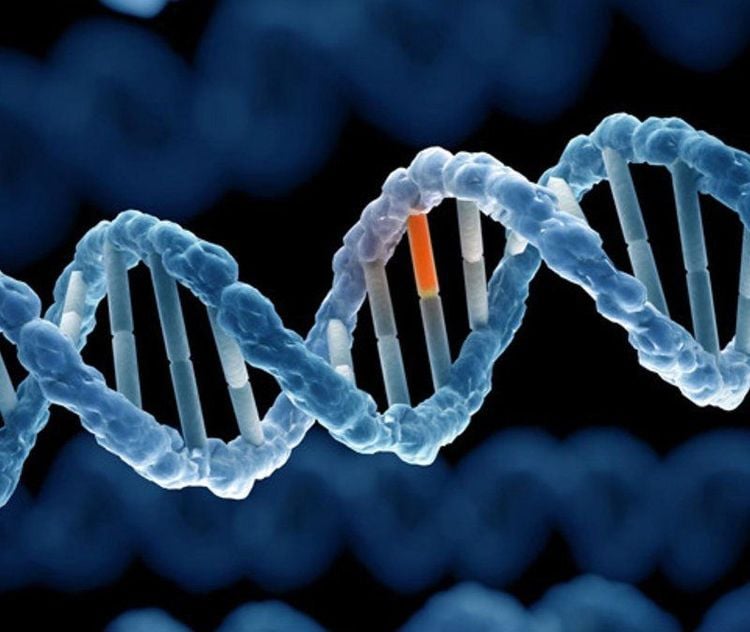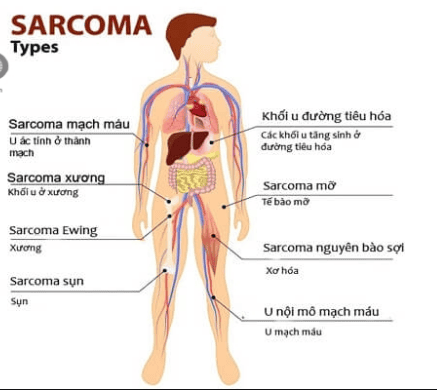This is an automatically translated article.
Soft tissue sarcoma is a rare and malignant cancer that tends to affect children and adults. It not only seriously affects health but also causes heavy psychological pressure for patients.1. What is soft tissue sarcoma?
Soft tissue sarcoma is a malignant cancer that originates in the body's soft tissues (including muscles, tendons, fat, lymph, blood vessels, and nerves). These cancers can develop anywhere in the body but are found mainly in the arms, legs, chest, and abdomen.Soft tissue sarcoma comes in many different types, and it tends to affect children and the elderly.
2. Symptoms of soft tissue sarcoma
In its early stages, soft tissue sarcoma usually doesn't cause any unusual signs or symptoms. Therefore, the disease is often detected at a late stage. As the disease progresses, it will cause the following symptoms for the patient, including:An abnormal tumor appears on the body and causes swelling. As the tumor grows, it will press on nerves and muscles, causing pain for the patient. Stomach and bowel obstruction or gastrointestinal bleeding if the tumor is in the abdomen or gastrointestinal tract. Abdominal pain is getting worse. Passing blood or black stools. Vomiting blood In the early stages, soft tissue sarcoma usually does not cause any unusual signs and symptoms. Therefore, the disease is often detected at a late stage. As the disease progresses, it will cause the following symptoms for the patient, including: An abnormal tumor appears on the body and causes swelling. As the tumor grows, it will press on nerves and muscles, causing pain for the patient. Stomach and bowel obstruction or gastrointestinal bleeding if the tumor is in the abdomen or gastrointestinal tract. Abdominal pain is getting worse Passing stools with blood or black stools Vomiting blood

Khi bệnh tiến triển người bệnh có thể sẽ gặp tình trạng nôn ra máu
Rhabdomyosarcoma: Children most affected by this type of sarcoma are children. They usually occur in skeletal muscle. Leiomyosarcoma: Usually occurs in smooth muscles (muscles not under voluntary control). In addition, this type of sarcoma is most commonly found in the intestinal tract, uterus, and the lining of blood vessels. Hemangiosarcoma: Appears in a blood vessel, arm, leg, or trunk. Kaposi's sarcoma is a type of malignant cancer that occurs in the walls of blood vessels. It tends to affect people with weakened immune systems. Lymphangiosarcoma: This type of cancer usually affects the lymph vessels or in a limb has chronic swelling (lymphedema), possibly from an area of previous radiation therapy or a certain chronic infection. Synovial sarcoma: Affects tissues around joints such as knees and ankles. The disease is common in children and young adults. Neurofibrosarcoma: Usually occurs in peripheral nerves Liposarcoma: Affects legs and trunk. Fibrosarcoma: Affects fibrous tissue in the arms, legs, or body. Malignant histiocytoma: Occurs in the legs. Dermatofibrosarcoma: Appears in the tissues under the skin, trunk or limbs. If you see any of the signs and symptoms listed above, you should go to reputable medical facilities for timely examination and treatment.
3. Causes of soft tissue sarcoma
Currently, the medical community has not come to an exact conclusion about the cause of soft tissue sarcoma. Some types of soft tissue sarcoma are caused by Kaposi's sarcoma, which is caused by the herpes virus 8 and usually occurs in people with weakened immune systems.Below are some of the main factors that cause soft tissue sarcoma, namely:
3.1 Genetic factors Soft tissue sarcoma can be inherited if a parent has sarcoma in the family. Some types of sarcoma can be inherited, such as cellular nevus syndrome, inherited retinoblastoma (a rare form of eye cancer in children), Li-Fraumeni syndrome, Gardner syndrome, tuberous sclerosis, neurofibromatosis, Werner syndrome.
3.2 Radiation exposure People who have had other cancers treated with radiation therapy can also develop soft tissue sarcoma, as this is one of the side effects caused by the treatment. cancer.
3.3 Chemical exposure People are more likely to get soft tissue sarcoma if they are regularly exposed to harmful chemicals such as herbicides containing the chemicals phenoxy acetic acid, toxic dioxin-products. A by-product of many industrial chemical manufacturing processes involving chlorine, or high exposure to vinyl chloride, is used as a plasticizer.

Sarcoma mô mềm có thể được di truyền nếu trong gia đình cha mẹ bị mắc sarcoma
4. Diagnosis of soft tissue sarcoma
Because there are so many different types of soft tissue sarcomas, it is important to accurately determine the nature of each tumor so that the best treatment can be selected.If your doctor suspects you may have soft tissue sarcoma, he or she will ask about your medical history, perform a physical exam, or take biopsies from your tumors for testing.
4.1 Surgical biopsy The doctor makes an incision through the skin and removes the entire tumor or part of it. In certain cases, the patient may be given local anesthesia. However, people with deep tumors need to have the procedure under anesthesia before surgery.
4.2 Imaging tests Imaging tests may be done to help your doctor see and evaluate potential areas for soft tissue sarcoma, including X-rays, computed tomography (CT) scans. computerized scanning, positron emission tomography (PET), ultrasound, magnetic resonance imaging (MRI).
Based on tests, the doctor will distinguish the stages of the disease:
Stage I: Soft tissue sarcomas are small tumors that have not spread to lymph nodes or nearby parts of the body. body.
Stage II: This is the advanced stage of soft tissue sarcoma, the cells begin to show abnormal signs and divide rapidly. However, it has not yet spread to the lymph nodes and other areas of the body.
Stage III: The malignant cells have spread to one or more lymph nodes.
Stage IV: Abnormal cells grow and divide rapidly, cancer can be found in the lymph nodes and other parts of the body.
5. Treatment of soft tissue sarcoma
Like other cancers, the treatment of soft tissue sarcoma will depend on the location, size, type of cancer and stage of the disease to choose the right treatment for each patient. The following are the commonly used methods in the treatment of soft tissue sarcoma:5.1 Surgery The most common treatment for soft tissue sarcoma. It is especially effective in cases where malignant cells have not spread to nearby areas of the body. Surgery removes the cancerous tissue along with some healthy tissue around it. In cases where the sarcoma has spread, the doctor may recommend surgical removal of the primary and secondary tumors.
5.2 Radiation Therapy Radiation therapy can affect both cancer cells and healthy cells. However, healthy cells will be better able to recover from the effects of radiation than cancer cells. Radiation therapy can also be given before surgery to shrink cancerous tumors or after surgery to stop the growth of remaining cancer cells.
5.3 Chemotherapy Chemotherapy is the use of drugs to kill rapidly dividing cancer cells in the digestive tract, bone marrow, reproductive system or hair follicles. In addition, this is a systemic therapy, it is able to treat metastatic cells.
6. Methods to help deal with soft tissue sarcoma

Bạn nên hỏi bác sĩ về tình trạng sarcoma mô mềm của mình, gồm có các lựa chọn điều trị và tiên lượng bệnh
6.1 Get information about soft tissue sarcoma You should ask your doctor about your soft tissue sarcoma, including your options. treatment and prognosis. The more thoroughly you learn about the disease, the more confident you will be in making treatment decisions.
6.2 Be proactive Instead of being depressed or tired, you should take the initiative to make treatment decisions for yourself, because sometimes you have an active role in the treatment of the disease.
6.3 Find support from family or friends You should keep close and close relationships with your loved ones and friends, because they are the ones who can help you cope with the illness like caregiving. squirrel, encourage you.
6.4 Maintain daily activities When you have cancer, it doesn't mean you have to stop all activities, stop doing the things you enjoy. If you are eligible and healthy, try to maintain your daily activities to keep your life balanced, mentally also become more comfortable to cope with the disease.
Early cancer screening is considered the "golden key" for early detection and effective cancer prevention and treatment regimens, thereby reducing the risk of death and reducing costs for people. sick. Currently, Vinmec has been and is a leading medical facility in the field of detection, the high-tech cancer screening package at Vinmec gives you the opportunity to screen and detect timely warning risks. to optimize treatment efficiency, improve quality of life.
Any questions about cancer screening at Vinmec, please come directly to the hospital or contact HERE for answers.
MORE:
What makes cancer cells different from normal cells How do cancer cells form, grow and spread? How does the immune system affect cancer cells?













